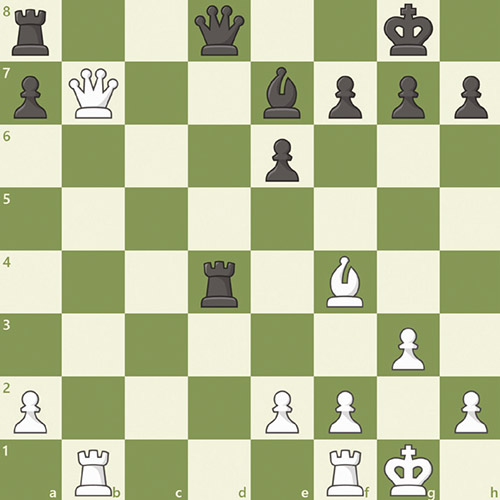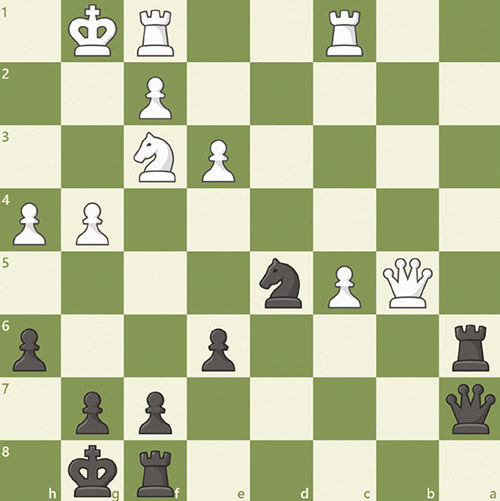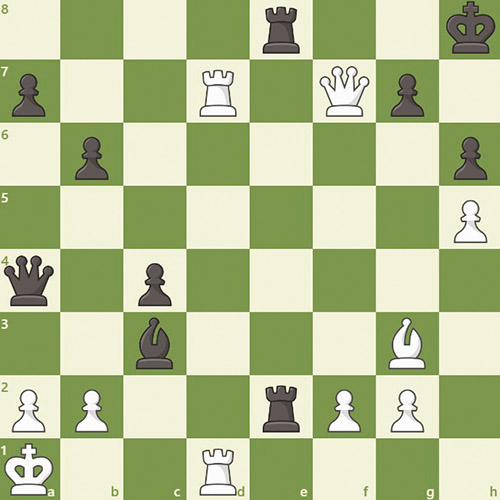
In chess, interference is when the connection between an attacked piece and its defender is interrupted by interposing a piece between them, often sacrificially. This concept is demonstrated in Figure 1, a position from a game between Soviet Grandmasters Vasily Smyslov and Alexander Tolush at the 1961 Central Chess Club International. Material and pawn placement is equal and both sides have a queen and rook battery in the open files, but the critical detail is that the white queen is attacking the a8 rook, which is defended by the black queen on d8. Therefore, white can play the interference tactic bishop to b8, disconnecting the queen and the rook which the white queen is now threatening to capture. The rook is trapped and queen to d5, the only move black can make to defend it, leaves the e7 bishop hanging to the white queen.

Figure 2 is a position from a game between Grandmasters Hikaru Nakamura with the white pieces and Alexander G. Beliavsky with black at the 2005 HB Global Chess Challenge. White is up a pawn but black has far more active pieces and can take advantage of the placement of the white queen to win tempi and the c pawn. Therefore, Beliavsky began with 1… Rb8, activating his f8 rook on the open file and pushing back the white queen. 2. Qe2 Ra2 and black continued activating his rooks while also attacking the queen. 3. Rc2 Nc3, where it cannot be taken by the c2 rook because of the pin against the e2 queen and cutting off white’s defense of the c5 pawn so that the black queen can soon capture it after 4. Qd3 Rxc2 5. Qxc2 Qxc5. Although white has given back the pawn, Hikaru then uses the new placement of the black queen to create counterplay with 6. Rc1, attacking the pinned knight. 6… Rc8, a counter threat that prepares Ne2+, forking the king and rook, and the queen cannot capture because it is pinned to the c1 rook. Nakamura avoids the tactic with 7. Kg2 Qc4 8. Nd4 as the players continue to activate their pieces. Beliavsky then takes advantage of the placement of the knight on d4 and the undefended g4 pawn behind it with the move 8… e5, kicking out the knight so that black can capture on g4 with 9. Nf5 Qxg4+ 10. Kh2. However, the game is still equal as white can create counterplay on the g file against black’s king, spurring black to move the king off the g file with 10… Kh8. 11. Rg1 Qh5 and here Hikaru played 12. Rxg7, a seemingly strong move that blunders the interference idea 12… e4. Defended by the c3 knight, e4 cuts off the white queen’s defense of the f5 knight and if the knight moves out of the black queen’s attack, the g7 rook is left hanging so Hikaru resigned.

The position displayed in Figure 3 is from a game between Simon Winawer with white and Mikhail Chigorin with black in Warsaw from 1882. White is piling heavy pressure against the g7 pawn and black’s king, however black is completely winning with the brilliant interference sacrifice: Bishop to d4. The idea of the move is twofold; firstly it blocks the queen from attacking g7 and secondly, after queen takes d4 which Winawer played, the white queen no longer guards the f3 pawn, allowing Chigorin to capture on f3 with his queen. Rook to g2 is forced to block the check and black continues to apply pressure on the pinned rook with bishop to h3. After the rook moves to g1 to defend the g2 rook, black then has rook to e8 to attack the e4 knight, which cannot move because if it does, black can checkmate white by taking on g2 with the bishop and then playing rook to e1. Therefore, white is forced to give up both the knight and the exchange because after a move like queen to c3, which white played in the game, black can play bishop takes g2 check and after the g1 rook recaptures, black can then take the knight on e4. Black finishes the combination up a rook for a bishop and two extra pawns, a completely winning endgame.

Figure 4 is from a game between Grandmaster Tony Miles with white and International Master Craig Pritchett with black at the 1982 6th Lloyds Bank Masters Open. Here, black’s attack against the white king is completely winning if not for one move that instead wins the game for white: the interference sacrifice bishop to e5. Black resigned in this position because the bishop on e5 beautifully cuts off the vital circulation and connection of black’s pieces. Firstly, it threatens checkmate on g7 by blocking the c3 bishop, an obstruction that remains if either rook captures the bishop. Additionally, it disconnects the black rooks so that if black takes with the c3 bishop to defend g7, the e8 rook is left defenseless to the white queen on f7. Therefore, black has to sacrifice his queen for either of white’s rooks to prevent the checkmating idea, and white has a winning, material advantage.
Ethan Feder is a junior at Yeshivat Frisch, a chess enthusiast and player. The goal of his column is to teach and discuss chess concepts through example positions, high-level games and relevant puzzles, along with explanations. Feel free to contact him with any questions, suggestions or comments at [email protected].











